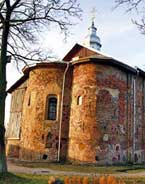 Over half a century it has been on the verge of falling down into the River Neman. Not a suicide killer or a victim of dire straits, but a beauty that had long stayed unrecognized. The cathedral of St. Boris and Gleb was built on the high visibility site opposite the Grodno castle in 1180s by unknown masters. The bank of the river was a bit further off water and it was some time later that it “slid” in the river. The sanctuary stood encircled by whispering oak-trees in the rove once dedicated to pagan deities. When first Christians arrived here, they baptised the pagans and constructed a church made of stone. Stone cathedrals were a rarity at that time, as it was faster, cheaper and simpler to make a wooden one.
Over half a century it has been on the verge of falling down into the River Neman. Not a suicide killer or a victim of dire straits, but a beauty that had long stayed unrecognized. The cathedral of St. Boris and Gleb was built on the high visibility site opposite the Grodno castle in 1180s by unknown masters. The bank of the river was a bit further off water and it was some time later that it “slid” in the river. The sanctuary stood encircled by whispering oak-trees in the rove once dedicated to pagan deities. When first Christians arrived here, they baptised the pagans and constructed a church made of stone. Stone cathedrals were a rarity at that time, as it was faster, cheaper and simpler to make a wooden one.Who were those missionaries, who brought Christianity to the Neman banks? Maybe Bulgarians? Or Serbs? Or residents of Volyn area from the neighbouring Ukraine? In Grodno Region, where the yatvyag tribes used to live, stones were used as tombs. Therefore, it is very unlikely that the church was made by the yatvyags and “the parents” of the Kolozha church are being looked for abroad, in southern lands. Scientists are still puzzled, where this stunning look of the church came from. Made from thin brick, it has a special decor with fine cobblers as if gathered from pagan temples and re-sanctified for a new cult holding the church body, while above shines the enamel of multi-coloured patterns with crosses and flowers laid with ceramic tile. The facade is furnished with ceramic insets. Some of them have faded and crumpled, while others have been steadily reflecting sunshine and transforming in the summer rain. When washed clean, they do not give any sign that they have been “sitting” in the wall for several centuries.
The interior of the cathedral surprises even more. Only one half of it remained intact. The second part that fell into Neman was re-built from wood in the late XIX century. The authentic part pleases the eye with the remaining frescos. But strange “holes” in the walls is what surprises most. When you get a closer look at them, they cease to seem weird. A hand put inside feels some sort of a container. These containers used to serve as a cache. In fact, they are resonators, jars built in the wall to create an acoustic effect.
This is the only church in Belarus and Eastern Europe that has such installations.
How could a church have stood unweathered for so long? A special recipe of solution that solidifies the bricks is its secret: lime was mixed with crushed brick, thinly cut straw and charcoal nubbles. The dome and arcs have failed, however, to stand the test of time — they crumbled in the XVI century. The ancient floor made of majolica tile in the XII century turned into modest fragments depicting cross-like objects.
Once the cathedral had a neighbour — a monastery, around which common folk lived. The legend has it that the place acquired its name after Vytautas, the grand duke of Lithuania and duke of Grodno, ordered imprisoned craftsmen from Kolozha, the suburbs of Pskov, to move here.
So the people started calling the church after the name of the suburb.
There were times, when there were several “Kolozhas” in Grodno.
The cathedrals, architectural masterpieces, are thought to have gone up in smoke in 1183, after the yatvyags, local pagans, raided the Orthodox city.
However that may be, Kolozha is a hallmark of arts development in Grodno at the time of its inception. Kolozha is a symbol of Belarus and its inimitable culture. So it is not surprising that the church is now regarded as a likely entry to the UNESCO world heritage list. The value of the Belarusian sanctuary for both Belarusian and world culture is unquestionable.
Sofy Shumskaya











